Where Are Kidneys Located on A Woman and A Man Body?
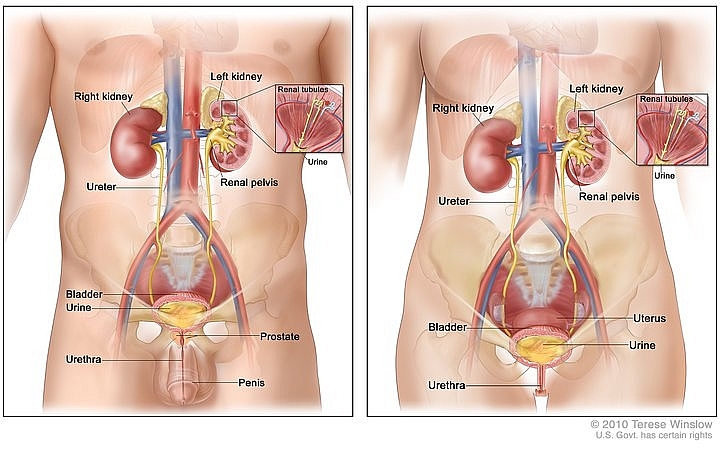 |
| Kidney pain is felt in the sides or back |
Where Are Kidneys Located on A Woman and A Man Body?
The kidneys are two bean-shaped organs, each about the size of a fist.
Your kidneys are located in the back of your abdomen, just under your ribcage, on each side of your spine.
Anatomy of the male urinary system (left panel) and female urinary system (right panel).
The two-panel drawing showing the right and left kidneys, the ureters, the bladder filled with urine, and the urethra. The inside of the left kidney shows the renal pelvis. An inset shows the renal tubules and urine.
Also shown are the prostate and penis (left panel) and the uterus (right panel).
Anatomy of the male urinary system (left panel) and female urinary system (right panel) showing the kidneys, ureters, bladder, and urethra.
Urine is made in the renal tubules and collects in the renal pelvis of each kidney. The urine flows from the kidneys through the ureters to the bladder.
The urine is stored in the bladder until it leaves the body through the urethra.
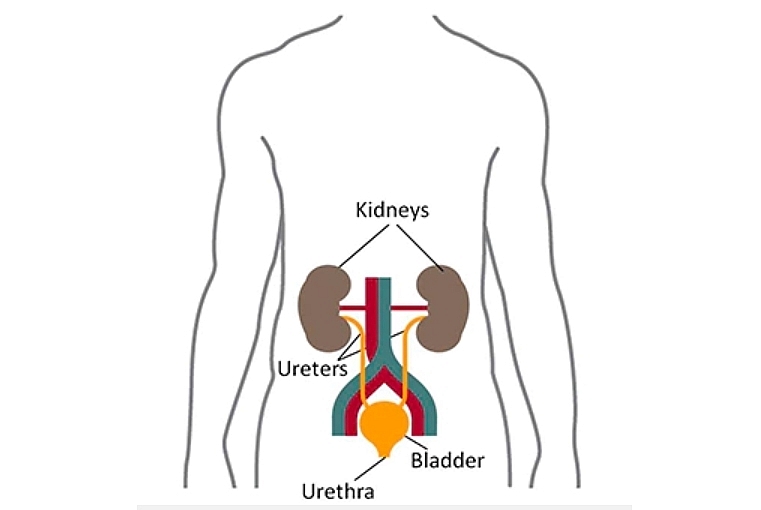 |
| Kidneys Located on Human Body |
Healthy kidneys filter about a half cup of blood every minute, removing wastes and extra water to make urine. The urine flows from the kidneys to the bladder through two thin tubes of muscle called ureters, one on each side of your bladder. Your bladder stores urine. Your kidneys, ureters, and bladder are part of your urinary tract.
What is the function of the kidneys?
The excess waste products and excess fluid are removed when the kidneys produce urine that is excreted from the body. Moreover, the kidneys play an important role in the regulation of the body's salt, potassium, and acid content.
The kidneys also produce hormones that stimulate the production of red blood cells that help regulate blood pressure and help control calcium and electrolyte metabolism in the body.
How kidneys work
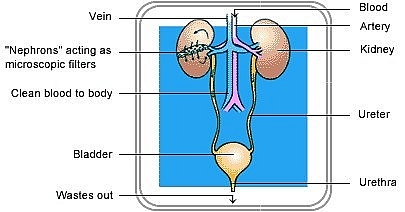 |
| How do kidneys work? |
Your kidneys remove wastes and extra fluid from your body. Your kidneys also remove acid that is produced by the cells of your body and maintain a healthy balance of water, salts, and minerals—such as sodium, calcium, phosphorus, and potassium—in your blood.
Without this balance, nerves, muscles, and other tissues in your body may not work normally.
Your kidneys also make hormones that help:
*control your blood pressure
*make red blood cells NIH external link
*keep your bones strong and healthy
Each of your kidneys is made up of about a million filtering units called nephrons. Each nephron includes a filter, called the glomerulus, and a tubule. The nephrons work through a two-step process: the glomerulus filters your blood, and the tubule returns needed substances to your blood and removes wastes.
The glomerulus filters your blood: As blood flows into each nephron, it enters a cluster of tiny blood vessels—the glomerulus. The thin walls of the glomerulus allow smaller molecules, wastes, and fluid—mostly water—to pass into the tubule. Larger molecules, such as proteins and blood cells, stay in the blood vessel.
The tubule returns needed substances to your blood and removes wastes: A blood vessel runs alongside the tubule. As the filtered fluid moves along the tubule, the blood vessel reabsorbs almost all of the water, along with minerals and nutrients your body needs. The tubule helps remove excess acid from the blood. The remaining fluid and wastes in the tubule become urine.
Blood flows into your kidney through the renal artery. This large blood vessel branches into smaller and smaller blood vessels until the blood reaches the nephrons. In the nephron, your blood is filtered by the tiny blood vessels of the glomeruli and then flows out of your kidney through the renal vein.
Your blood circulates through your kidneys many times a day. In a single day, your kidneys filter about 150 quarts of blood. Most of the water and other substances that filter through your glomeruli are returned to your blood by the tubules. Only 1 to 2 quarts become urine.
What is kidney pain and Where do you feel kidney pain?
If a person feels pain in their side or experiences tenderness around their lower back, it could indicate kidney issues.
Pain in your sides or middle to upper back could be coming from your kidneys. However, having pain in your back or sides does not necessarily mean there is something wrong with your kidneys. It is possible to have pain on only one side if only one kidney has a problem, or both sides if both kidneys are affected.
A person may feel kidney pain under the lower part of their rib cage. They may feel kidney pain on either their right or left side, or they may experience it on both sides at the same time.
Kidney pain may also come from the middle or upper part of a person’s back. They may also feel pain relating to the kidneys anywhere in the urinary system, such as the bladder.
Kidney pain in the back: If a person experiences pain in their mid to upper back, it could indicate that there is something wrong with their kidneys.
Kidney pain in the back may be a constant ache, or it may be sharp and sudden. Some people may describe it as a “stabbing” pain.
The most common causes of kidney pain that radiates to the back are infections and kidney stones.
A kidney infection may have started with a urinary tract infection (UTI).
Kidney stones can cause a person to experience excruciating pain that feels like spasms. This pain may also spread to the groin.
However, if kidney pain worsens when a person bends over or lifts something, it may be the result of back muscle or bone problems rather than an issue affecting the kidney.
Pain in the groin: A person may also feel kidney pain in their groin. This may happen because pain can radiate to areas of the body other than where it originates.
Males may feel kidney-related pain in their testicles.
However, if testicular pain is accompanied by enlargement, redness, or changes to the scrotal skin, the problem might be a primary issue with the testicle. If this is the case, they should seek medical advice.
Pain while passing urine: If a person experiences a stinging or burning pain while urinating, they may have a urine or bladder infection.
Some other symptoms of infection include:
- wanting to pass urine very often
- pain at the bottom of the abdomen
- foul smelling urine
- cloudy urine
Bacteria in the bladder can cause kidney infections.
A person with any of these symptoms should contact a doctor.
What does kidney pain feel like?Kidney pain may feel like a constant, dull pain or ache. Alternatively, it may be excruciating and sharp. If a doctor gently presses on or taps the person’s flank area, the pain may worsen. What the pain feels like will likely depend on its cause. Also, individuals may feel and respond to kidney pain differently. |
What causes kidney pain?
Pain is the main way that our body tells us something is wrong. Unfortunately everything is not as simple as might be expected. First, some of the most important causes of kidney failure don’t cause pain in the kidneys. Secondly, not all pains that come from the areas of the kidneys come from the kidneys. When assessing someone with pain, a doctor has to be careful and may need to perform at lot of tests which can take some time. Even after tests, a doctor may not be absolutely sure of the cause of pain.
Pain can come from any part of the kidneys and urine drainage system. The next few paragraphs try to describe how pain occurs with various types of kidney problem. Please remember that everyone is different, so that people feel pain in different ways and in different places. Also, peoples’ bodies and minds respond to pain in different ways.
Type of Kidney Pain
People use different words to describe pain, for example - aching, stabbing, excruciating, agonising. It is very helpful for doctors to know some of the following information to understand more about the pain:
- where does the pain start?
- does the pain travel from a starting point to another place?
- is the pain constant or does it come and go?
- if pain comes and goes, does anything make it go away (such as passing water, or bending over, or lifting weights)?
Commonest Causes of Kidney Pain
The kidneys are found in the upper back (the ‘small of the back’, it is often called). Kidney disease can cause pain in this part of the upper back. Although this is true, pain in this area often comes from the muscles of the back, or from the spine. Pain from the kidneys is often constant, or can be sharp, like being stabbed. Pain from the muscles or the spine comes on with bending over or with lifting, and may be felt in the middle of the back or on either side of the back.
The commonest causes of kidney pain in the back are:
*Infection - An infection in a kidney is called acute pyelonephritis.
*Kidney stones - These can cause a very, very severe pain that comes on in spasms, and travels down to the groin, and is called renal colic by doctors.
Some of the causes of kidney pain or flank pain are as follows:
- Urinary tract infections (UTI)
- Bladder infection (cystitis)
- Kidney infections (pyelonephritis)
- Hydronephrosis
- Kidney stones (nephrolithiasis and/or ureterolithiasis)
- Kidney cancer
- Anything that compresses the kidney (for example, a large tumor)
- Glomerulonephritis
- Blood clots in the kidneys (renal vein thrombosis)
- Polycystic kidney disease (congenital)
- Congenital malformations in the renal system resulting in complete or partial blockage of urine flow
- Drugs or toxins that harm kidney tissue (for example, pesticide exposure or chronic use of medications such as ibuprofen [Advil, Motrin, and others])
- Kidney pain during pregnancy
- Kidney bleeding (hemorrhage) such as from penetrating trauma or blunt trauma ("kidney laceration")
- End-stage renal disease
What are the first signs and symptoms that are associated with kidney pain?
Symptoms associated with kidney pain (also termed renal or flank pain) are discomfort (acute or chronic), aches, or sharp pain that occurs in the back between approximately the lowest rib and the buttock. Depending on the cause of the pain, it may radiate down the flank to the groin or toward the abdominal area. Some individuals may develop symptoms and signs such as:
- Fever
- Painful urination (dysuria)
- Blood in the urine
- Nausea
- Vomiting
- Dizziness
- Constipation or diarrhea
- Rash
- Fatigue
- Chills
Other symptoms and signs that may occur if the kidney function is increasingly compromised are a
- metallic taste in the mouth,
- bad breath,
- swelling and shortness of breath.
Depending on the underlying cause, kidney pain may occur on the left or right side. Sometimes it can occur on both sides of the back; traumatic kidney injury (kidney laceration) may cause the above symptoms, but mild damage may initially have no symptoms. Severe kidney lacerations can cause abnormal blood pressure and pulse, and shock.
Kidney pain itself is a symptom that may happen due to problems or diseases of the kidney or its associated structures, including the ureters or bladder. However, other diseases may mimic kidney pain, but are not actually due to the kidneys, for example,
- muscle strains in the back,
- spinal problems (fracture, abscesses),
- rib pain,
- pleuritis,
- radiculitis,
- retroperitoneal fibrosis,
- shingles,
- aortic abdominal aneurysm,
- gynecological problems, and
- many other causes.
Although kidney pain often occurs on one side of the back, it can occur on both sides at the same time and may radiate toward the abdomen or groin.
Pain that occurs suddenly is sharp, severe, and may increase and decrease in waves is often due to kidney stones in the ureters of the kidneys. Pain caused by kidney stones is termed renal colic.
Is kidney causing back pain?I have nagging back pain on my right side and I worry it might be my kidney. How can you tell when back pain is a problem with the kidney? People commonly think their back pain comes from their kidney. But it’s more likely that your discomfort is due to muscle spasm or strain or a spine-related problem. The kidneys are located higher than most people realize (see image). So back pain, one of the most common problems that sends people to their doctors, is rarely due to kidney trouble. When pain is related to a kidney issue, not only is the pain higher up in the back, but the symptoms are also different. For instance, a kidney stone that gets lodged in the ureter (the tube that runs from the kidney to the bladder) causes waves of intense pain rather than the steady ache of typical low back pain. And a person with a kidney infection (pyelonephritis) almost always has a fever along with flank pain. If your pain is localized to the area of the kidney as shown in the illustration, you should see your doctor. Your doctor will tap on your flank to see if it is tender. He or she then will likely order a urine test to look for red and white blood cells and a blood test to make sure the kidneys are functioning normally. Based on these results, your doctor might also recommend an ultrasound or CT scan. Source: By Howard E. LeWine, MD, Chief Medical Editor, Harvard Health Publishing |
What is the treatment for kidney pain?
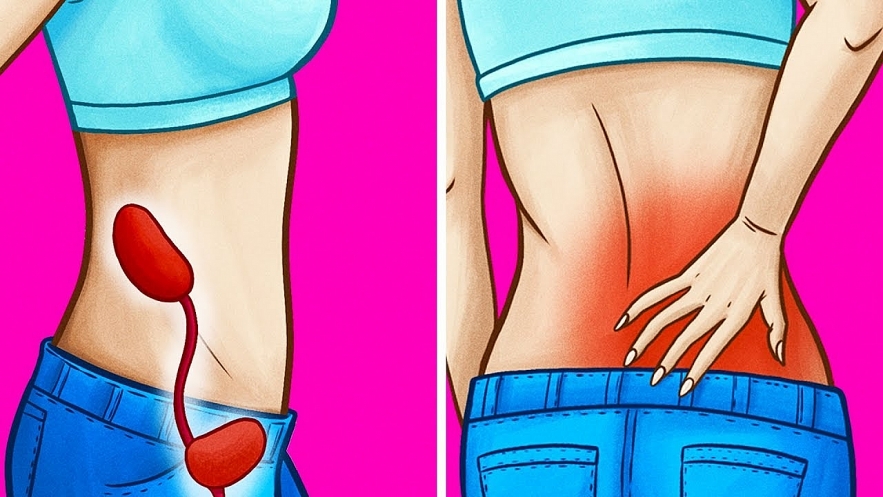 |
| Treatment for kidney pain |
The treatment for kidney pain depends on what is causing it. Your health care provider might want you to have a urine test to check for signs of an infection. You may also need to have imaging tests, such as an ultrasound or CT scan, to help figure out what is causing your pain. When your health care provider knows what is causing your pain, he or she can prescribe the right treatment for you.
- Kidney pain (flank pain) treatment depends on the underlying cause of the pain.
- Kidney infections and kidney stones that cause pain are often treated with ibuprofen, ketorolac (Toradol), acetaminophen (Tylenol and others), or occasionally with small amounts of morphine (kidney stones). However, these agents treat pain (pain relief only) and not the underlying cause(s) of pain.
- Some patients may spontaneously pass (urine sweeps the irritating kidney stone out of the ureters and/or urethra) small kidney stones (usually less than about 6 mm in diameter) and then be pain-free.
- Infections like urinary tract infections (UTIs) and pyelonephritis usually require antibiotic treatments in addition to pain medications.
- If kidney stones completely block a ureter or are about 6 mm in diameter or larger, they may require urologic surgery. Usually, recovery time is fast (same day or a few days) if kidney stones are removed by retrograde surgical techniques. However, some severe kidney lacerations may require more extensive surgery. Recovery time for these surgeries varies from weeks to months.
- Other underlying causes of flank pain may need similar pain management and concurrent treatments. However, patients with known kidney problems (kidney disease) and/or renal function compromise should not be treated with pain medications that are either filtered (removed) through the kidneys and/or may cause further renal damage.
How to Relieve Kidney Pain at Home
Relieving Kidney Pain at Home – Urinary Infections
If you’re suffering from kidney pain due to an infection in the urinary tract, try the following remedies. If they don’t work, make sure to schedule a visit with your urologist to discuss a treatment plan that will ensure the infection doesn’t spread.
- Increase Water Intake
Hydration is key to flushing out infections of the urinary tract. Not only will staying hydrated help eliminate bacteria, it can relieve pain by reducing the concentration of your urine. Instead of turning to sugary drinks, increase your water intake. Water is always a better option as it causes less irritation. As a general rule of thumb, aim for 8, 8oz glasses a day.2 If you’re active or have a strenuous lifestyle you may need more water to stay hydrated.
- Take Probiotics
Probiotics help fight bacteria build-up in your gut and replaces it with good, immune boosting bacteria.3 Regularly taking probiotics may also help your kidney process waste, thus making treatments more effective.3
- Add Some Cranberry Juice
UTIs are oftentimes associated with cranberry juice and for good reason—it helps alleviate pain. Avoid overly processed cranberry juice cocktails and instead, opt for pure juice or some sort of supplement to help mitigate kidney pain and reduce the symptoms of a UTI.
- Run a Warm Bath with Epsom Salt
Epsom salt acts as a detoxifying agent and helps your body relax as a whole. This isn’t a long-term remedy, but taking a warm bath with Epsom salt will help your body relax and reduce your discomfort while you’re soaking.
- Add Heat
If the bath doesn't help, try adding direct heat with a heating pad or a heated water bottle. Place it on the affected area for about 20 minutes at a time to help reduce any pain.2
- Take Non-Aspirin Pain Killers
Aspiring is a blood thinner, which may cause bloody urine if taken when experiencing kidney pain.1 To help relieve the pain, opt for non-aspiring pain killers like Ibuprofen or Advil.
- Try Parsley
Parsley is a diuretic that helps increase the frequency and amount of urine that you pass.3 This helps further eliminate any bacterial buildup in the urinary tract and fights infection. If parsley juice on it’s own sounds too gross too handle, try adding it into smoothies with cranberry juice to mask the flavor.
- Avoid Irritants
Limit your intake of alcohol and coffee, both of which irritate the urinary tract. Drinking irritants during an infection reduces the effectiveness of your body’s natural healing process and may increase dehydration.
- Increase Your Apple Intake
The acidity of apples can help your kidneys maintain acid in the urine, which will reduce the likelihood of the bacterial infection spreading.3 Apples are also great at fighting inflammation, which can help relieve pain.3
- Drink Green Tea
Some studies suggest that green tea can have antibacterial effects on bacteria that cause UTIs. To experience this effect, drink plenty of green tea or opt for a more concentrated green tea extract.
Relieving Kidney Pain at Home – Kidney Stones
If you’re suffering from kidney pain due to the presence of kidney stones, try the above solutions. Since they will help reduce the irritation on your urinary tract, they can also alleviate pain from kidney stones. In addition, there are a few other things to do that will help you alleviate kidney pain from kidney stones at home.
- Manage Your Alcohol Intake
While it’s recommended to reduce your overall alcohol intake, and completely eliminate it while on antibiotics, wine has been shown to aid in the prevention of kidney stones and any associated pain.2 Red wine is also filled with beneficial antioxidants. Limit your intake to 5oz a day and continue drinking plenty of water.
- Increase Acidic Consumption
As we mentioned, acidic foods have the potential to reduce kidney pain. They have also been shown to actively fight kidney stones.2 Increase your acidic consumption, but don’t go overboard.
- Add a Splash of Citrus
The best way to increase your acidic consumption is by adding a splash of citrus fruits to your water. Try a combination of lemons, oranges, grapefruits, and limes for the best results.
When to See Your Urologist
While it would be nice to avoid the doctor’s office for kidney pain, it’s not always possible. Sometimes, the pain is not treatable using an at-home remedy and you’ll need to see your doctor or urologist to get relief. It should also be noted that just because you experience pain relief, doesn’t mean that your infection is gone. To make sure that the infection doesn’t spread to other parts of your body and cause further complications, you need to get a proper diagnosis and treat the problem. If you have a high fever, blood in your urine, vomiting, or chills, see your doctor immediately.1 If you experience back, groin, or abdominal pain, see your doctor.3 always better to seek medical treatment early to treat any serious infections and reduce the risks of complications or severe problems.
If you have kidney stones, but the pain is persistent and you’re unable to pass them on your own, your urologist will recommend additional treatments. There are a number of different things that can be done to reduce the size of kidney stones and make them easier to pass naturally. Call your doctor if the pain persists and you’re unable to pass kidney stones on your own.
| Kidney pain can cause severe disruptions to every day life. To help mitigate the pain, try some of these at-home remedies. If you’re still experiencing pain, or have other symptoms of an infection, call your urologist today. To learn more about urological supplies, urology problems and complications, or educational resource, visit our educational support page or our product selection guide. Byram is proud to be a full-service urological care supplier and we have all of the high quality urological supplies you need. As an added bonus, all of your supplies can be discreetly delivered to your home, any time of the day. If you have any questions or are looking for personalized, confidential services, our teams of knowledgeable urological customer service specialists are here to help. |
When should you call doctor?
See your doctor if you have persistent pain in the kidney area, and if you have back pain along with any of the following symptoms:
- Fever
- Discolored urine
- Painful urination
- Blood in the urine
- A repeated urgent need to urinate
- The appearance of solid material (kidney stones) in the urine
- A general feeling of illness or lethargy that will not go away
What procedures and tests diagnose kidney diseases?
The doctor usually will do a history and physical examination. Initial tests usually consist of a complete blood count (CBC), kidney function (creatinine and BUN), and urine test, and when appropriate, a pregnancy test. A lacerated kidney may be suspected if the person has experienced a traumatic injury to the lower back.
If kidney stones are suspected, a CT exam (renal protocol or noncontrast spiral CT) or renal ultrasound is done; an abdominal X-ray (KUB) may be ordered but has been replaced in general by ultrasound and CT. As patients with kidney stones often need repeat X-ray studies or have repeat episodes of kidney stones, ultrasound with its lack of radiation is a good study to consider. Abdominal/pelvic CTs with contrast or magnetic resonance imaging (MRI) and aortogram may be ordered to further define or differentiate underlying kidney (renal) and nonrenal causes of flank pain. Such studies are routinely performed if a kidney is suspected to be damaged by a traumatic event (auto accident, gunshot wound, or blunt trauma such as from a collision in football or workplace injury).
How improve kidney health?
Monitor your blood pressure - High blood pressure accelerates kidney damage. To protect yourself from kidney disease you should also maintain a diet low in salt and saturated fats.
Keep fit and active - This helps reduce your blood pressure and therefore reduces the risk of kidney disease.
Don’t smoke - Smoking slows blood flow to the kidneys, deceasing their ability to function properly.
Eat healthily and keep your weight in check - This can help prevent diabetes, heart disease and other conditions associated with kidney disease.
Get your kidney function checked - If anyone in your family has suffered from kidney disease, you are diabetic or have high blood pressure or if you are of South Asian or African-Caribbean ethnic background.
Editor Note: Knowinsiders.com cannot accept responsibility for information provided. The above is for guidance only. Patients are advised to seek further information from their own doctor.
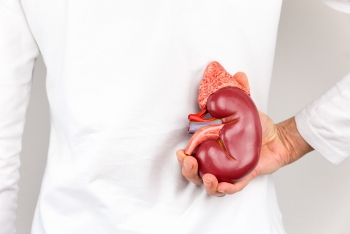 7 interesting Facts about our Kidney 7 interesting Facts about our Kidney Kidneys, the third biggest-ticket organ you can legally sell in the U.S, function as very important organs in our body. We can't live without them, ... |























